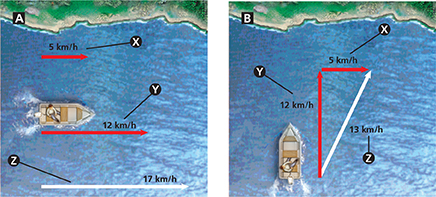Combining Velocities
Sometimes the motion of an object involves more than one velocity.
 Two or more velocities add by vector addition. The velocity of the river relative to the riverbank (X) and the velocity of the boat relative to the river (Y) in Figure 10A combine. They yield the velocity of the boat relative to the riverbank (Z). This velocity is 17 kilometers per hour downstream.
Two or more velocities add by vector addition. The velocity of the river relative to the riverbank (X) and the velocity of the boat relative to the river (Y) in Figure 10A combine. They yield the velocity of the boat relative to the riverbank (Z). This velocity is 17 kilometers per hour downstream.
In Figure 10B, the relative velocities of the current (X) and the boat (Y) are at right angles to each other. Adding these velocity vectors yields a resultant velocity of the boat relative to the riverbank of 13 km/h (Z). Note that this velocity is at an angle to the riverbank.
Figure 10 Vector addition is used when motion involves more than one velocity. A The velocity of the boat in the reference frame of the riverbank (17 km/h) is a combination of the relative velocities of the boat and the river. B You can determine the resultant velocity of the boat relative to the riverbank (13 km/h) by measuring from the tail of one vector to the head of the other.

Section 11.2 Assessment
Reviewing Concepts
 What does velocity describe?
What does velocity describe? What shows the speed on a distance-time graph?
What shows the speed on a distance-time graph? What is the difference between average speed and instantaneous speed?
What is the difference between average speed and instantaneous speed? How can two or more velocities be combined?
How can two or more velocities be combined?
Critical Thinking
Applying Concepts Does a car's speedometer show instantaneous speed, average speed, or velocity? Explain.
Designing Experiments Describe an experiment you could perform to determine the average speed of a toy car rolling down an incline.
Applying Concepts Explain why the slope on a distance-time graph is speed. (Hint: Use the definition of speed on page 332 and the graphs in Figure 7.)
Math Practice
An Olympic swimmer swims 50.0 meters in 23.1 seconds. What is his average speed?
A plane's average speed between two cities is 600 km/h. If the trip takes 2.5 hours, how far does the plane fly? (Hint: Use the average speed formula in the form




